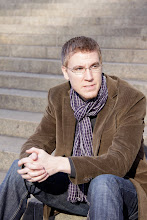Continuing on with Marianne H. Micks appraisal of the role of space in liturgy she suggests that while theologians have suppressed or ignored the spatial character of liturgy it is prevalent in contemporary imagination (particularly the sciences and arts). Contemporary humanity, a
skip to main |
skip to sidebar


An axis of access is a sacred place which our life revolves around. We hold them dear in our memory. They thrive in our imagination. They root us to this world. (To read more about the nature of this blog read the originating post from 08.07.07)
About Me

- rstander
- Grand Forks, ND, United States
- i am recent MFA grad from University of North Dakota. while i have range of interests, my ongoing research continues to explore the nature of place/space through artistic and liturgical lenses.
Blog Archive
-
▼
2008
(186)
-
▼
August
(23)
- Moby
- Want God, Not Religion?
- The Spatial Character of Liturgy II
- Another New Header
- Counting Crows
- The Spatial Character of Liturgy
- Weezer
- found objects: shoes II
- Goldfrapp
- The Who @ Woodstock
- Can These Bones Live?: A Catholic Baptist Engageme...
- Crosby Stills and Nash @ Woodstock
- Jefferson Airplane @ Woodstock
- Eisenstein's Montage and Photography
- Joe Cocker @ Woodstock
- Authority, Sola Scriptura, and Individualism
- Richie Havens @ Woodstock
- Woodstock: the 39th Anniversary
- Celebrating One Year of Axis Of Access
- Deep Dish
- Posting
- Cowgirl by Underworld from Everything Everything
- Over the Rhine
-
▼
August
(23)
Labels
- abandonment
- aesthetics
- architecture
- Art
- artists
- books
- canada
- cartography
- commodified memory
- consumerism
- contested space
- CTS-AAR Photos
- Devotions
- Elevator Series
- Film
- graffiti
- individualism
- iowa
- kitsch
- lectionary readings
- liturgy
- Luke
- Mark
- minnesota
- misc.
- misc. education
- Montana
- music
- nationalism
- new topographics
- North Dakota
- northwestern college
- photographers
- photography
- pilgrimage
- PKAP
- priests in film
- printmaking
- Psalms
- questioning God
- religion as a chain of memory series
- retro signage
- sacred space
- saskatchewan
- scripture
- shoes
- sioux falls seminary
- south dakota
- stray shopping carts
- TH 541
- theological musings
- threshold series
- University of North Dakota
- Video
- visiting artists
- weather reports
Explore
- University of North Dakota
- Sioux Falls Seminary
- Northwestern College
- The Chronicle of Higher Education
- Inside Higher Ed
- College Theology Society
- Image Journal
- Christians in the Visual Arts (CIVA)
- College Art Association
- National Association of Baptist Professors of Religion (NABPR)
- American Academy of Religion
- The Ekklesia Project
- Speaking of Faith
- NT Wright Page
- Textweek.com
- Good Shepherd Episcopal
- Internet Movie Data Base (IMDB)
- The Simpson's
Exhibition Opportunities
Theology & The Arts
Theology and the Arts Academic Programs
My Blog List






